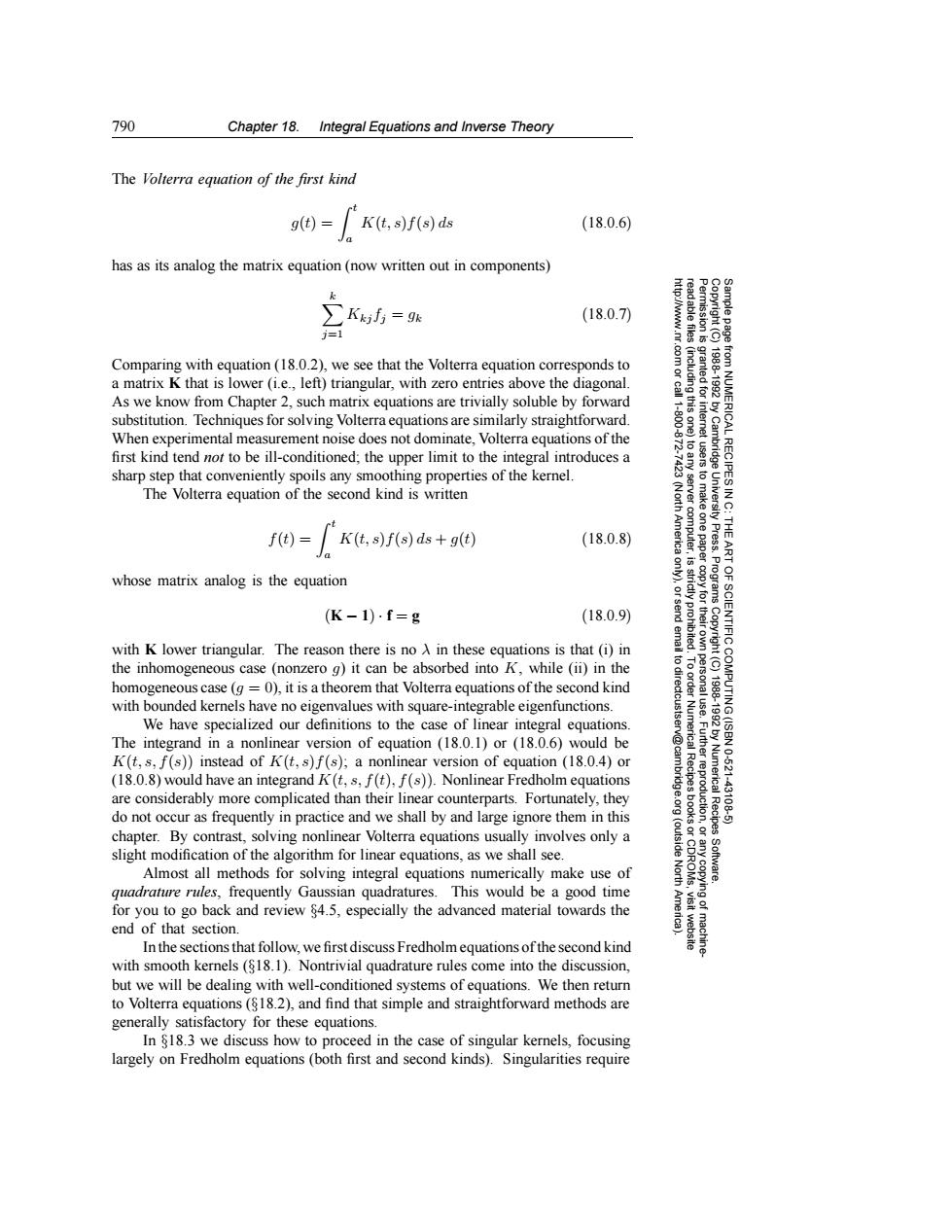正在加载图片...

790 Chapter 18.Integral Equations and Inverse Theory The Volterra equation of the first kind g(t)= K(t,s)f(s)ds (18.0.6) has as its analog the matrix equation(now written out in components) Kkf方=9k (18.0.7) j=1 Comparing with equation (18.0.2),we see that the Volterra equation corresponds to a matrix K that is lower(i.e.,left)triangular,with zero entries above the diagonal As we know from Chapter 2,such matrix equations are trivially soluble by forward substitution.Techniques for solving Volterra equations are similarly straightforward. When experimental measurement noise does not dominate,Volterra equations of the first kind tend not to be ill-conditioned;the upper limit to the integral introduces a sharp step that conveniently spoils any smoothing properties of the kernel. RECIPES The Volterra equation of the second kind is written 9 f(t)=K(t,s)f(s)ds+g(t) (18.0.8) 县P whose matrix analog is the equation 9分% 9 (K-1)·f=g (18.0.9) with K lower triangular.The reason there is no A in these equations is that(i)in the inhomogeneous case (nonzero g)it can be absorbed into K,while(ii)in the homogeneous case(g =0),it is a theorem that Volterra equations of the second kind with bounded kernels have no eigenvalues with square-integrable eigenfunctions. We have specialized our definitions to the case of linear integral equations. The integrand in a nonlinear version of equation (18.0.1)or (18.0.6)would be 复N K(t,s,f(s))instead of K(t,s)f(s);a nonlinear version of equation (18.0.4)or (18.0.8)would have an integrand K(t,s,f(t),f(s)).Nonlinear Fredholm equations Numerica 10-521 are considerably more complicated than their linear counterparts.Fortunately,they 431 do not occur as frequently in practice and we shall by and large ignore them in this Recipes chapter.By contrast,solving nonlinear Volterra equations usually involves only a slight modification of the algorithm for linear equations,as we shall see. Almost all methods for solving integral equations numerically make use of guadrature rules,frequently Gaussian quadratures.This would be a good time for you to go back and review 84.5,especially the advanced material towards the end of that section. In the sections that follow,we first discuss Fredholm equations of the second kind with smooth kernels (818.1).Nontrivial quadrature rules come into the discussion. but we will be dealing with well-conditioned systems of equations.We then return to Volterra equations($18.2),and find that simple and straightforward methods are generally satisfactory for these equations. In 818.3 we discuss how to proceed in the case of singular kernels,focusing largely on Fredholm equations (both first and second kinds).Singularities require790 Chapter 18. Integral Equations and Inverse Theory Permission is granted for internet users to make one paper copy for their own personal use. Further reproduction, or any copyin Copyright (C) 1988-1992 by Cambridge University Press. Programs Copyright (C) 1988-1992 by Numerical Recipes Software. Sample page from NUMERICAL RECIPES IN C: THE ART OF SCIENTIFIC COMPUTING (ISBN 0-521-43108-5) g of machinereadable files (including this one) to any server computer, is strictly prohibited. To order Numerical Recipes books or CDROMs, visit website http://www.nr.com or call 1-800-872-7423 (North America only), or send email to directcustserv@cambridge.org (outside North America). The Volterra equation of the first kind g(t) = t a K(t, s)f(s) ds (18.0.6) has as its analog the matrix equation (now written out in components) k j=1 Kkjfj = gk (18.0.7) Comparing with equation (18.0.2), we see that the Volterra equation corresponds to a matrix K that is lower (i.e., left) triangular, with zero entries above the diagonal. As we know from Chapter 2, such matrix equations are trivially soluble by forward substitution. Techniques for solving Volterra equations are similarly straightforward. When experimental measurement noise does not dominate, Volterra equations of the first kind tend not to be ill-conditioned; the upper limit to the integral introduces a sharp step that conveniently spoils any smoothing properties of the kernel. The Volterra equation of the second kind is written f(t) = t a K(t, s)f(s) ds + g(t) (18.0.8) whose matrix analog is the equation (K − 1) · f = g (18.0.9) with K lower triangular. The reason there is no λ in these equations is that (i) in the inhomogeneous case (nonzero g) it can be absorbed into K, while (ii) in the homogeneous case (g = 0), it is a theorem that Volterra equations of the second kind with bounded kernels have no eigenvalues with square-integrable eigenfunctions. We have specialized our definitions to the case of linear integral equations. The integrand in a nonlinear version of equation (18.0.1) or (18.0.6) would be K(t, s, f(s)) instead of K(t, s)f(s); a nonlinear version of equation (18.0.4) or (18.0.8) would have an integrand K(t, s, f(t), f(s)). Nonlinear Fredholm equations are considerably more complicated than their linear counterparts. Fortunately, they do not occur as frequently in practice and we shall by and large ignore them in this chapter. By contrast, solving nonlinear Volterra equations usually involves only a slight modification of the algorithm for linear equations, as we shall see. Almost all methods for solving integral equations numerically make use of quadrature rules, frequently Gaussian quadratures. This would be a good time for you to go back and review §4.5, especially the advanced material towards the end of that section. In the sections that follow, we first discuss Fredholm equations of the second kind with smooth kernels (§18.1). Nontrivial quadrature rules come into the discussion, but we will be dealing with well-conditioned systems of equations. We then return to Volterra equations (§18.2), and find that simple and straightforward methods are generally satisfactory for these equations. In §18.3 we discuss how to proceed in the case of singular kernels, focusing largely on Fredholm equations (both first and second kinds). Singularities require�